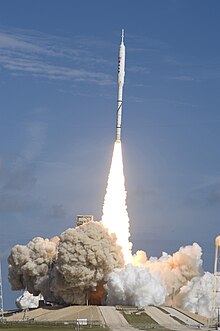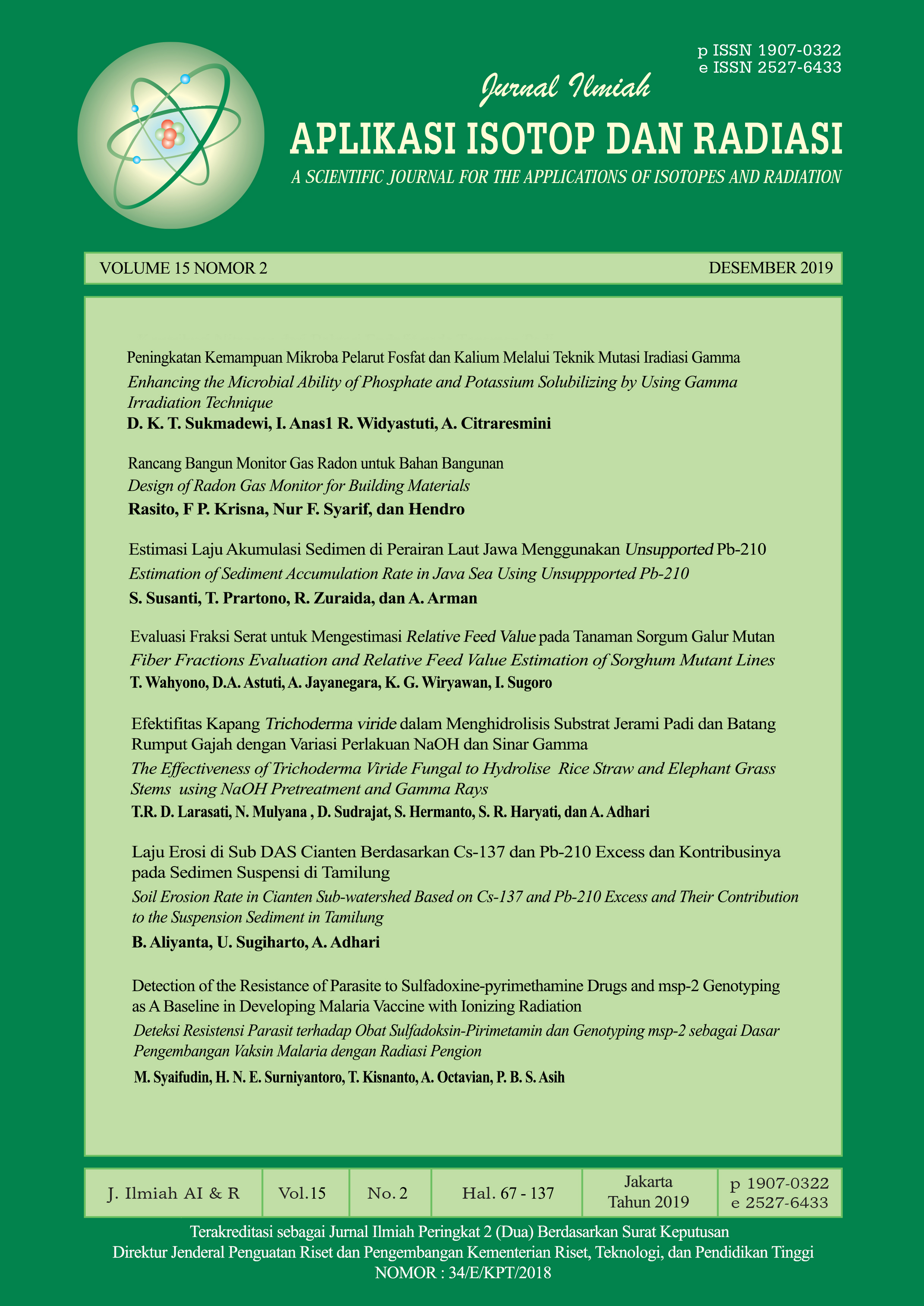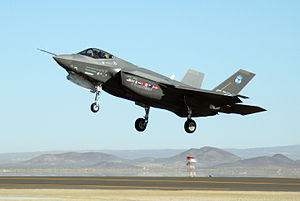Indonesian Space Force Command
Komando
Untuk Keamanan Luar Angkasa
Dari Angkatan Antariksa Indonesia
“You cannot simultaneously prevent and prepare for war.”
~Albert Einstein~
| F-35 Lightning II |
|
|
| An F-35A Lightning II, marked AA-1, lands at Edwards Air Force Base, California |
| Role | Stealth multirole fighter |
| National origin | United States |
| Manufacturer | Lockheed Martin Aeronautics |
| First flight | 15 December 2006 |
| Introduction | 2016[1]-2018[2][3] |
| Status | In limited production, undergoing flight testing |
| Produced | 2006–present |
| Number built | 13 flight-test aircraft[N 1] |
| Unit cost | F-35A: US$122 million (flyaway cost, 2011)[6]
F-35B: US$150M (avg. cost, 2011)[7]
F-35C: US$139.5M (avg. cost, 2011)[7][8]
Note: Average costs excludes development cost[7]
F-35A weapons system unit cost is US$183.5M (FY 2011)[6] |
| Developed from | Lockheed Martin X-35 |
Design
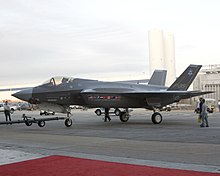
F-35A being towed to its inauguration ceremony on 7 July 2006
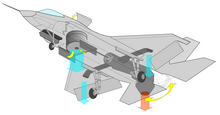
F-35B's thrust vectoring nozzle and lift fan
The F-35 appears to be a smaller, slightly more conventional, single-engine sibling of the sleeker, twin-engine
Lockheed Martin F-22 Raptor, and indeed drew elements from it. The exhaust duct design was inspired by the
General Dynamics Model 200 design, which was proposed for a 1972 supersonic VTOL fighter requirement for the
Sea Control Ship.
[67] For specialized development of the F-35B STOVL variant, Lockheed consulted with the
Yakovlev Design Bureau, purchasing design data from their development of the
Yakovlev Yak-141 "Freestyle".
[68][69] Although several experimental designs have been built and tested since the 1960s including the Navy's unsuccessful
Rockwell XFV-12, the F-35B is to be the first operational supersonic, STOVL stealth fighter.
[70]
The F-35 has a maximum speed of over Mach 1.6. With a maximum takeoff weight of 60,000 lb (27,000 kg),
[N 3][72] the Lightning II is considerably heavier than the lightweight fighters it replaces. In empty and maximum gross weights, it more closely resembles the single-seat, single-engine
Republic F-105 Thunderchief, which was the largest single-engine fighter of the
Vietnam war era. However the F-35's modern engine delivers over 60 percent more thrust in an aircraft of the same weight so that in thrust to weight and wing loading it is much closer to a comparably equipped F-16.
[N 4]
Acquisition deputy to the assistant secretary of the Air Force, Lt. Gen. Mark D. "Shack" Shackelford has said that the F-35 is designed to be America's "premier surface-to-air missile killer and is uniquely equipped for this mission with cutting edge processing power, synthetic aperture radar integration techniques, and advanced target recognition."
[74][75]
Some improvements over current-generation fighter aircraft are:
- Durable, low-maintenance stealth technology, using structural fiber mat instead of the high-maintenance coatings of legacy stealth platforms;[76]
- Integrated avionics and sensor fusion that combine information from off and on board sensors to increase the pilot's situational awareness and improve target identification and weapon delivery, and to relay information quickly to other command and control (C2) nodes;
- High speed data networking including IEEE 1394b[77] and Fibre Channel.[78]
- The Autonomic Logistics Global Sustainment (ALGS), Autonomic Logistics Information System (ALIS) and Computerized Maintenance Management System (CMMS) help ensure aircraft uptime with minimal maintenance manpower.[79]
- Electrohydrostatic actuators run by a power-by-wire flight-control system.[80]
Lockheed Martin claims the F-35 is intended to have close and long-range air-to-air capability second only to that of the F-22 Raptor.
[9] The company has suggested that the F-35 could also replace the USAF's F-15C/D fighters in the air superiority role and the F-15E Strike Eagle in the ground attack role, but it does not have the range or payload of either F-15 model.
[81] The F-35A does carry a similar air-to-air armament as the
Boeing F-15SE Silent Eagle when both aircraft are configured for low observable operations and has over 80 percent of the larger aircraft's combat radius.
[82]
The F-35 program has learned from the corrosion problems that the F-22 had when it was first introduced in 2005. The F-35 uses a gap filler that causes less
galvanic corrosion to the skin, is designed with fewer gaps in its skin that require gap filler, and has better drainage.
[85]
A United States Navy study found that the F-35 will cost 30 to 40 percent more to maintain than current jet fighters.
[86] And a Pentagon study found that it may cost $1 trillion to maintain the entire fleet over its lifetime.
[87]
Engines
The Lift System is composed of a lift fan, drive shaft, two roll posts and a "Three Bearing Swivel Module" (3BSM).
[92] The 3BSM is a
thrust vectoring nozzle which allows the main engine exhaust to be deflected downward at the tail of the aircraft. The lift fan is near the front of the aircraft and provides a counter-balancing thrust using two counter-rotating
blisks.
[93] It is powered by the engine's low-pressure (LP) turbine via a drive shaft and gearbox. Roll control during slow flight is achieved by diverting unheated engine
bypass air through wing mounted thrust nozzles called Roll Posts.
[94][95] Like lift engines, the added lift fan machinery increases payload capacity during vertical flight, but is dead weight during horizontal flight. The cool exhaust of the fan also reduces the amount of hot, high-velocity air that is projected downward during vertical take off, which can damage runways and aircraft carrier decks.
[citation needed]
To date, F136 funding has come at the expense of other parts of the program, reducing the number of aircraft
built and increasing their costs.
[96] The F136 team has claimed that their engine has a greater temperature margin which may prove critical for VTOL operations in hot, high altitude conditions.
[97]
Pratt & Whitney is also testing higher thrust versions of the F135, partly in response to GE's claims that the F136 is capable of producing more thrust than the 43,000 lbf (190 kN) supplied by early F135s. The F135 has demonstrated a maximum thrust of over 50,000 lbf (220 kN) during testing.
[98] The F-35's Pratt & Whitney F135 is the most powerful engine ever installed in a fighter aircraft.
[99]
The F135 is the second (radar) stealthy afterburning jet engine and like the
Pratt & Whitney F119 from which it was derived, has suffered from pressure pulsations in the afterburner at low altitude and high speed or "screech". In both cases this problem was fixed during development of the fighter program.
[100]
Turbine bearing health in the engine will be monitored with thermoelectric powered wireless sensors.
[101]
Armament
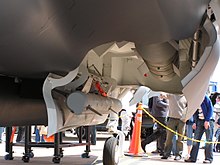
Weapons bay on a
mock-up of the F-35
The F-35A includes a GAU-22/A, a four-barrel version of the
GAU-12 Equalizer 25 mm cannon.
[102] The cannon will be mounted internally with 180 rounds in the F-35A and fitted as an external pod with 220 rounds in the F-35B and F-35C.
[103][104] The gun pod for the B and C variants will have stealth features. This pod could be used for different equipment in the future, such as EW, reconnaissance equipment, or possibly a rearward-facing radar.
[105]
Internally, up to two 2,000 lb (910 kg) air-to-ground bombs can be carried in A and C models (BRU-68) (two 1,000 lb (450 kg) bombs in the B model (BRU-67)
[106][107]) along with two smaller weapons, normally expected to be air-to-air missiles. Lockheed Martin says on its website that the weapons load can also be configured as all-air-to-ground or all-air-to-air, and has suggested that a Block 5 version will be able to carry three internal weapons per bay instead of two, replacing the heavy bomb with two smaller weapons such as
AIM-120 AMRAAM air-to-air missiles.
[108]
Missiles and bombs to be carried inside the weapon bays include
AIM-120 AMRAAM,
AIM-132 ASRAAM, the
Joint Direct Attack Munition (JDAM) – up to 2,000 lb (910 kg), the
Joint Stand off Weapon (JSOW),
Small Diameter Bombs (SDB) – a maximum of four in each bay (three per bay in F-35B,
[109] or four
GBU-53/B in each bay for all F-35 variants;
[110] a set of up to four
small diameter bombs takes the place of a single larger bomb),
Brimstone anti-armor missiles, and Cluster Munitions (WCMD).
[107] The
MBDA Meteor air-to-air missile is currently being adapted to fit four internally in the missile spots and may be integrated into the F-35. A modified Meteor design with smaller tailfins for the F-35 was revealed in September 2010.
[111] The United Kingdom had originally planned to put up to four AIM-132 ASRAAM internally but this has been changed to carry 2 internal and 2 external ASRAAMs.
[112] The external ASRAAMs will add only an insignificant amount to the F-35's radar cross section and will allow attacks to slightly beyond visual range without using radar that might alert the target.
[113]
At the expense of being more detectable by radar, many more missiles, bombs and fuel tanks can be attached on four wing pylons and two near wingtip positions. The two wingtip locations can only carry
AIM-9X Sidewinder. The other pylons can carry the AIM-120 AMRAAM,
Storm Shadow,
AGM-158 Joint Air to Surface Stand-off Missile (JASSM) cruise missiles, guided bombs, 480 US gallons (1,800 L) and 600 US gallons (2,300 L) fuel tanks.
[114] An air-to-air load of eight AIM-120s and two AIM-9s is conceivable using internal and external weapons stations, as well as a configuration of six 2,000 lb (910 kg) bombs, two AIM-120s and two AIM-9s.
[107][115] With its payload capability, the F-35 can carry more weapons payload than the legacy fighters it is to replace as well as the F-22 Raptor.
[116] Solid-state lasers were being developed as optional weapons for the F-35 as of 2002.
[117][118][119]
While the F-35 will take on the
Wild Weasel mission, it will lack the ability to carry an anti-radiation missile internally (and therefore stealthily) until the
JDRADM is fielded in 2025.
[120]
Norway and Australia are funding a program to adapt the
Naval Strike Missile (NSM) to fit the internal bays of the F-35. This will be a multirole version, named the Joint Strike Missile (JSM), and will be the only cruise missile to fit the internal bays. Studies have shown that the F-35 would be able to carry two of these internally, while four additional missiles could be carried externally. The missile has an expected range in excess of 150 nmi (278 km).
[121] On 12 April 2011 the Norwegian Ministry of Defence announced phase 2 of development with a cost estimate of 1029 MNOK.
[122]
The
B61 nuclear bomb was scheduled for deployment in 2017, but delays in the F-35 program may delay this.
[123]
External links












